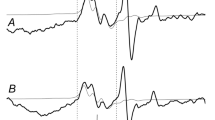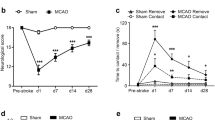Abstract
The purpose of this study was to determine whether exposure to an extremely low-frequency magnetic field (ELF-MF, 50 Hz) affects the outcome of postischemic damage in the hippocampus of Mongolian gerbils. After 10-min bilateral carotid occlusion, the gerbils were continuously exposed to ELF-MF (average magnetic induction at the center of the cage was 0.5 mT) for 7 days. The impact of ELF-MF was estimated immediately (the 7th day after reperfusion) and 7 days after cessation of exposure (the 14th day after reperfusion) compared with ischemic gerbils without ELF-MF exposure. Applying stereological methods, histological evaluation of changes in the hippocampus was done for determining its volume, volume densities of degenerating neurons and astrocytes, as well as the number of microglial cells per unit area. ELF-MF per se did not induce any morphological changes, while 10-min global cerebral ischemia led to neuronal death, especially in CA1 region of the hippocampus, as expected. Ischemic gerbils exposed to ELF-MF had significantly a lower degree of cell loss in the examined structure and greater responses of astrocytes and microglial cells than postischemic gerbils without exposure on the seventh day after reperfusion (immediate effect of ELF-MF). Similar response was observed on the 14th day after reperfusion (delayed effect of ELF-MF); however, differences in measured parameters were low and insignificant. Applied ELF-MF has possible neuroprotective function in the hippocampus, as the most sensitive brain structure in the model of global cerebral ischemia, through reduction of neuronal death and activation of astrocytes and microglial cells.





Similar content being viewed by others
References
Block F (1999) Global ischemia and behavioural deficits. Prog Neurobiol 58:279–295. doi:10.1016/S0301-0082(98)00085-9
Bodega G, Forcada I, Suárez I, Fernández B (2005) Acute and chronic effects of exposure to a 1-mT magnetic field on the cytoskeleton, stress proteins, and proliferation of astroglial cells in culture. Environ Res 98:355–362. doi:10.1016/j.envres.2004.12.010
Bokura H, Robinson R (1997) Long-term cognitive impairment associated with caudate stroke. Stroke 28:970–975. doi:10.1161/01.STR.28.5.970
Carlson N, Wieggel W, Chen J, Bacchi A, Rogers S, Gahring L (1999) Inflammatory cytokines IL-1a, IL-1ß, IL-6, and TNF- a impart neuroprotection to an excitotoxin through distinct pathways. J Immunol 163:3963–3968
Chen Y, Swanson R (2003) Astrocytes and brain injury. J Cereb Blood Flow Metab 23:137–149
Corbett D, Nurse S (1998) The problem of assessing effective neuroprotection in experimental cerebral ischemia. Prog Neurobiol 54:531–548. doi:10.1016/S0301-0082(97)00078-6
Crack P, Taylor J (2005) Reactive oxygen species and the modulation of stroke. Free Radic Biol Med 38:1433–1444. doi:10.1016/j.freeradbiomed.2005.01.019
Denes A, Thornton P, Rothwell N, Allan S (2010) Inflammation and brain injury: acute cerebral ischaemia, peripheral and central inflammation. Brain Behav Immun 24:708–723. doi:10.1016/j.bbi.2009.09.010
Di Loreto S, Falone S, Caracciolo V, Sebastiani P, D’Alessandro A, Mirabilio A, Zimmitti V, Amicarelli F (2009) Fifty hertz extremely low-frequency magnetic field exposure elicits redox and trophic response in rat-cortical neurons. J Cell Physiol 219:334–343. doi:10.1002/jcp.21674
Dong Y, Benveniste EN (2001) Immune function of astrocytes. Glia 36:180–190. doi:10.1002/glia.1107
Dorph-Petersen K, Nyengaard J, Gundersen H (2001) Tissue shrinkage and unbiased stereological estimation of particle number and size. J Microsc 204(Pt 3):232–246
Doyle KP, Simon RP, Stenzel-Poore MP (2008) Mechanisms of ischemic brain damage. Neuropharmacology 55:310–318. doi:10.1016/j.neuropharm.2008.01.005
Emsley H, Tyrrell P (2002) Inflammation and infection in clinical stroke. J Cereb Blood Flow Metab 22:1399–1419
Feuerstein G, Wang X, Barone FC (1998) Cytokines in brain ischemia—the role of TNF alpha. Cell Mol Neurobiol 18:695–701
Godefroy O, Rousseaux M, Pruvo J, Cabaret M, Leys D (1994) Neuropsychological changes related to unilateral lenticulostriate infarcts. J Neurol Neurosurg Psychiatry 57:480–485. doi:10.1136/jnnp.57.4.480
Gölfert F, Hofer A, Thümmler M, Bauer H, Funk RH (2001) Extremely low frequency electromagnetic fields and heat shock can increase microvesicle motility in astrocytes. Bioelectromagnetics 22:71–78
Gundersen H, Jensen E (1987) The efficiency of systematic sampling in stereology and its prediction. J Microsc 147:229–263. doi:10.1111/j.1365-2818.1987.tb02837.x
Imai F, Suzuki H, Oda J, Ninomiya T, Ono K, Sano H, Sawada M (2007) Neuroprotective effect of exogenous microglia in global brain ischemia. J Cereb Blood Flow Metab 27:488–500
Jinno S, Fleischer F, Eckel S, Schmidt V, Kosaka T (2007) Spatial arrangement of microglia in the mouse hippocampus: a stereological study in comparison with astrocytes. Glia 55:1334–1347. doi:10.1002/glia.20552
Kaszuba-Zwoińska J, Ciećko-Michalska I, Madroszkiewicz D, Mach T, Słodowska-Hajduk Z, Rokita E, Zaraska W, Thor P (2008) Magnetic field anti-inflammatory effects in Crohn’s disease depends upon viability and cytokine profile of the immune competent cells. J Physiol Pharmacol 59:177–187
Kato H, Takahashi A, Itoyama Y (2003) Cell cycle protein expression in proliferating microglia and astrocytes following transient global cerebral ischemia in the rat. Brain Res Bull 60:215–221. doi:10.1016/S0361-9230(03)00036-4
Kim S, de Vellis J (2005) Microglia in health and disease. J Neurosci Res 81:302–313. doi:10.1002/jnr.20562
Kirino T (1982) Delayed neuronal death in the gerbil hippocampus following ischemia. Brain Res 239:57–69. doi:10.1016/0006-8993(82)90833-2
Kreutzberg GW (1996) Microglia: a sensor for pathological events in the CNS. Trends Neurosci 19:312–318. doi:10.1016/0166-2236(96)10049-7
Larsson E, Lindvall O, Kokaia Z (2001) Stereological assessment of vulnerability of immunocytochemically identified striatal and hippocampal neurons after global cerebral ischemia in rats. Brain Res 913:117–132. doi:10.1016/S0006-8993(01)02762-7
Lee B, Johng H, Lim J, Jeong J, Baik K, Nam T, Lee J, Kim J, Sohn U, Yoon G, Shin S, Soh K (2004) Effects of extremely low frequency magnetic field on the antioxidant defense system in mouse brain: a chemiluminescence study. J Photochem Photobiol B 73:43–48. doi:10.1016/j.jphotobiol.2003.10.003
Levy D, Brierley J (1974) Communications between vertebro-basilar and carotid arterial circulations in the gerbil. Exp Neurol 45(3):503–508
Li L, Lundkvist A, Andersson D, Wilhelmsson U, Nagai N, Pardo AC, Nodin C, Ståhlberg A, Aprico K, Larsson K, Yabe T, Moons L, Fotheringham A, Davies I, Carmeliet P, Schwartz JP, Pekna M, Kubista M, Blomstrand F, Maragakis N, Nilsson M, Pekny M (2008) Protective role of reactive astrocytes in brain ischemia. J Cereb Blood Flow Metab 28:468–481. doi:10.1038/sj.jcbfm.9600546
Manikonda P, Rajendra P, Devendranath D, Gunasekaran B, Channakeshava AradhyaR, Sashidhar R, Subramanyam C (2007) Influence of extremely low frequency magnetic fields on Ca2+ signaling and NMDA receptor functions in rat hippocampus. Neurosci Lett 413:145–149. doi:10.1016/j.neulet.2006.11.048
Martin L, Al-Abdulla N, Brambrink A, Kirsch J, Sieber F, Portera-Cailliau C (1998) Neurodegeneration in excitotoxicity, global ischemia, and target deprivation: a perspective on the contributions of apoptosis and necrosis. Brain Res Bull 46:281–309. doi:10.1016/S0361-9230(98)00024-0
Murdoch J, Hall R (1990) Brain protection: physiological and pharmacological considerations. Part I: the physiology of brain injury. Can J Anaesth 37:663–671. doi:10.1007/BF03006487
Nakajima K, Kohsaka S (2001) Microglia: activation and their significance in the central nervous system. J Biochem 130:169–175
Neumann J, Gunzer M, Gutzeit HO, Ullrich O, Reymann KG, Dinkel K (2006) Microglia provide neuroprotection after ischemia. FASEB J 20:714–716
Nikolic L, Rokic M, Todorovic N, Kartelija G, Nedeljkovic M, Zakrzewska J (2010) Effect of alternating the magnetic field on phosphate metabolism in the nervous system of Helix pomatia. Biol Res 43:243–2500
Oda T, Koike T (2004) Magnetic field exposure saves rat cerebellar granule neurons from apoptosis in vitro. Neurosci Lett 365:83–86. doi:10.1016/j.neulet.2004.04.068
Panickar K, Norenberg M (2005) Astrocytes in cerebral ischemic injury: morphological and general considerations. Glia 50:287–298. doi:10.1002/glia.20181
Paxinos G, Franklin K (2004) The mouse brain in stereotaxic coordinates. Elsevier Academic Press, Oxford
Perry VH, Gordon S (1991) Macrophages and the nervous system. Int Rev Cytol 125:203–244. doi:10.1016/S0074-7696(08)61220-6
Peskine A, Picq C, Pradat-Diehl P (2004) Cerebral anoxia and disability. Brain Inj 18:1243–1254. doi:10.1080/02699050410001719899
Pirozzoli M, Marino C, Lovisolo G, Laconi C, Mosiello L, Negroni A (2003) Effects of 50 Hz electromagnetic field exposure on apoptosis and differentiation in a neuroblastoma cell line. Bioelectromagnetics 24:510–516. doi:10.1002/bem.10130
Rauš S, Selaković V, Radenović L, Prolić Z, Janać B (2012) Extremely low frequency magnetic field induced changes in motor behaviour of gerbils submitted to global cerebral ischemia. Behav Brain Res 228:241–246. doi:10.1016/j.bbr.2011.10.046
Redwine J, Kosofsky B, Jacobs R, Games D, Reilly J, Morrison J, Young W, Bloom F (2003) Dentate gyrus volume is reduced before onset of plaque formation in PDAPP mice: a magnetic resonance microscopy and stereologic analysis. Proc Natl Acad Sci USA 100:1381–1386. doi:10.1073/pnas.242746599
Ridet J, Malhotra S, Privat A, Gage F (1997) Reactive astrocytes: cellular and molecular cues to biological function. Trends Neurosci 20:570–577. doi:10.1016/S0166-2236(97)01139-9
Robertson J, Thomas A, Bureau Y, Prato F (2007) The influence of extremely low frequency magnetic fields on cytoprotection and repair. Bioelectromagnetics 28:16–30. doi:10.1002/bem.20258
Selaković V, Janać B, Radenović L (2010) MK-801 effect on regional cerebral oxidative stress rate induced by different duration of global ischemia in gerbils. Mol Cell Biochem 342:35–50. doi:10.1007/s11010-010-0466-x
Sherry D, Galef B Jr, Clark M (1996) Sex and intrauterine position influence the size of the gerbil hippocampus. Physiol Behav 60:1491–1494. doi:10.1016/S0031-9384(96)00311-3
Sobel E, Davanipour Z, Sulkava R, Erkinjuntti T, Wikstrom J, Henderson VW, Buckwalter G, Bowman JD, Lee PJ (1995) Occupations with exposure to electromagnetic fields: a possible risk factor for Alzheimer’s disease. Am J Epidemiol 142:515–524
Sugawara T, Fujimura M, Morita-Fujimura Y, Kawase M, Chan PH (1999) Mitochondrial release of cytochrome c corresponds to the selective vulnerability of hippocampal CA1 neurons in rats after transient global cerebral ischemia. J Neurosci 19:RC39
Swanson R, Choi D (1993) Glial glycogen stores affect neuronal survival during glucose deprivation in vitro. J Cereb Blood Flow Metab 13:162–169. doi:10.1038/jcbfm.1993.19
Taoufik E, Petit E, Divoux D, Tseveleki V, Mengozzi M, Roberts M, Valable S, Ghezzi P, Quackenbush J, Brines M, Cerami A, Prober L (2008) TNF receptor I sensitizes neurons to erythropoietinand VEGF-mediated neuroprotection after ischemic and excitotoxic injury. Proc Natl Acad Sci USA 105(16):6185–6190
von Bohlen und Halbach O, Unsicker K (2002) Morphological alterations in the amygdala and hippocampus of mice during ageing. Eur J Neurosci 16:2434–2440. doi:10.1046/j.1460-9568.2002.02405.x
Wender R, Brown A, Fern R, Swanson R, Farrell K, Ransom B (2000) Astrocytic glycogen influences axon function and survival during glucose deprivation in central white matter. J Neurosci 20:6804–6810
Wieraszko A, Armani J, Maqsood N, Raja H, Philip S (2005) Modification of the synaptic glutamate turnover in the hippocampal tissue exposed to low-frequency, pulsed magnetic fields. Brain Res 1052:232–235. doi:10.1016/j.brainres.2005.06.034
Wilson J (1997) Antioxidant defense of the brain: a role for astrocytes. Can J Physiol Pharmacol 75:1149–1163. doi:10.1139/cjpp-75-10-11-1149
Acknowledgments
This study was supported by a grant of the Ministry of Education and Science of the Republic of Serbia (Grant No. 173027) and MMA Grant (VMA/06-10/B.4). The authors are grateful to Dr. Spomenko Mihajlović (Department of Geomagnetism and Aeronomy, Sector for Geodetic Works, Republic Geodetic Authority, Republic of Serbia) for providing geomagnetic activity data. Also, we would like to thank Danijela Savić for generous help with Iba1-immunostaining method and image analysis.
Conflict of interest
The authors declare that there are no conflicts of interest.
Author information
Authors and Affiliations
Corresponding author
Rights and permissions
About this article
Cite this article
Rauš, S., Selaković, V., Manojlović-Stojanoski, M. et al. Response of Hippocampal Neurons and Glial Cells to Alternating Magnetic Field in Gerbils Submitted to Global Cerebral Ischemia. Neurotox Res 23, 79–91 (2013). https://doi.org/10.1007/s12640-012-9333-8
Received:
Revised:
Accepted:
Published:
Issue Date:
DOI: https://doi.org/10.1007/s12640-012-9333-8




